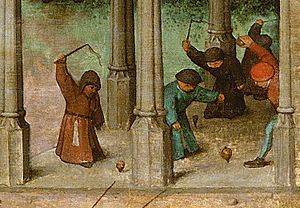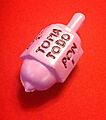Top facts for kids
A spinning top is a fun toy that spins on a small point. It has a round body and a sharp tip at the bottom. When you spin it, it balances on its tip because of something called the gyroscopic effect. This is the same effect that helps bicycles stay upright when they are moving.
When a top starts spinning, it might wobble a little at first. Then, it usually spins straight up for a while, almost like it's sleeping. As it loses energy, it starts to wobble more and more. Eventually, it tips over and rolls on its side.
Spinning tops come in many different shapes and are made from various materials. You can find them made of wood, metal, or plastic. Many tops have a metal tip to help them spin better. You can make them spin in different ways. Some are spun by twisting a handle with your fingers. Others use a rope wrapped around them. Some even have a special spiral plunger inside to get them going.
People have played with spinning tops for a very long time, since ancient times. Kids often play alone or in competitions. The goal is usually to keep your top spinning for as long as possible. Some tops have special sides with symbols. These are used like dice in games to add a bit of randomness. They can also be used for special rituals or telling the future.
Spinning tops are found all over the world. They are so common that some living things are even named after them! For example, a spider called Cyclosa turbinata gets its name from the Latin words for spinning top.
Contents
How to Spin a Top
There are several cool ways to get a spinning top moving. Each method works best for different types of tops.
Finger Twirling
Smaller tops often have a short stem or handle. You can make these tops spin by simply twirling the stem between your fingers. It's a quick and easy way to get them going. Even a thumbtack can be spun on its tip this way!
Using Strings and Whips

Many traditional tops are about the size of your fist. These are often made of wood with a metal tip. To spin them, you tightly wrap a string or rope around the top's body. It's best to start wrapping near the tip and move up. This helps keep the string tight as the top speeds up.
You can throw these tops forward while holding the end of the string. Pulling the string back quickly makes the top spin very fast. The way you throw it helps the string pull harder, making the top spin even faster.
Some people throw the top upside-down. The first part of the rope is wrapped around a small "head" on the top. When the string finishes unwinding, it gives a sudden tug. This makes the spinning top flip over and land perfectly on its tip!
Another way to keep these tops spinning is to hit them with a small whip. You can start the top by hand, then use the whip to keep it going longer.
Auger Tops
Some bigger tops use a special built-in metal auger. An auger is like a spiral plunger. With these tops, the spinning part might be hidden inside a hollow metal shell. The shell stays still, but the top inside spins. It looks like the toy is magically balancing on its tip!
Magnetic Field Tops
Modern tops can be very high-tech. Some are kept spinning forever by special magnetic fields. These fields come from a ground plate that the top sits on. It's like magic, but it's really science!
Types of Spinning Tops
There are many different kinds of spinning tops around the world. Some are made for battling, and others are for games or just for fun.
- Battling Tops: These tops are designed for competitions where players try to knock each other's tops over.
- Battling Tops
- Beigoma, from Japan
- Beyblade
- Gasing pangkah, from Malaysia
- Spin Fighters
- Tuj lub, played by Hmong people
- Gaming and Other Tops: These tops are used in games or have special features.
- Dreidel: A four-sided top played during the Jewish holiday of Hanukkah.
- Bambaram
- Levitating top: A top that floats and spins in the air.
- Bhawra: A gaming top used in Maharashtra, India.
- Perinola: A six-sided top, similar to the dreidel, used in Latin America.
- Rattleback: Also called a celt, this top can surprisingly reverse its spin direction.
- Teetotum
- Tippe top
- Trompo: Also known as a "Whipping top."
- Wizzzer
Today, many tops have cool new features. Their tips might be made of very hard materials like ruby or tungsten carbide. These materials are super smooth and reduce friction with the ground. This helps the top spin longer. Also, plastic and metal are now used more often than wood for making tops.
The Science of Spinning Tops

The way a top moves is explained by the science of how things spin. It's all about how a solid object rotates in space.
A top spins for a long time because its tip touches only a tiny area on the ground. Also, its body has a lot of "rotational inertia." This means it likes to keep spinning once it starts. A top on a hard surface can spin for many seconds, even without more pushes.
When a top first starts, it might wobble. Then, friction between the tip and the ground helps it spin steadily and upright. This is called the "sleep" position. If a top reaches this sleep position, less friction means it will stay in that position longer. However, overall, friction eventually slows it down. As it loses energy, it starts to wobble more and more. This wobbling is called "precession". Finally, the top falls over and rolls away.
You can make a top spin longer by making it heavier on the outside (increasing its "moment of inertia"). Also, lowering its "center of gravity" helps. But you have to make sure the body doesn't touch the ground while it spins!
Even tops that aren't perfectly round can be designed to balance and spin.
Spinning Top Competitions
Spinning tops are so popular that there are official competitions! You can find events like the U.S. National Championships in Chico, California. There are even World Championships held in places like Orlando, Florida. People compete to see whose top can spin the longest or perform special tricks.
Images for kids
-
Carved wooden rattleback
See also
 In Spanish: Peonza para niños
In Spanish: Peonza para niños




